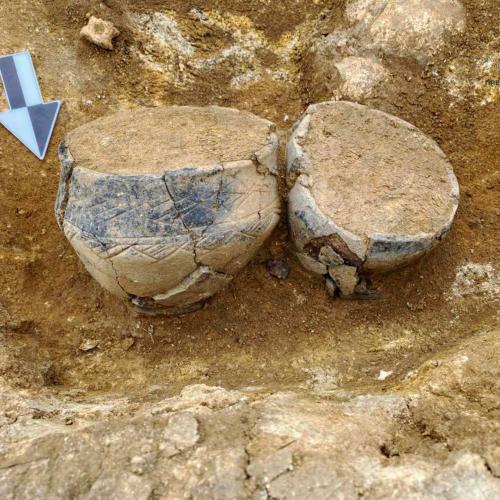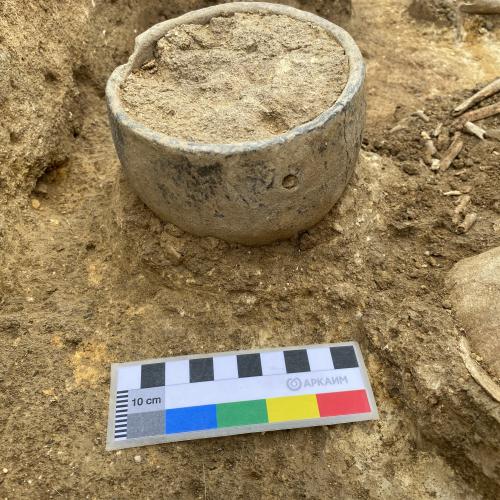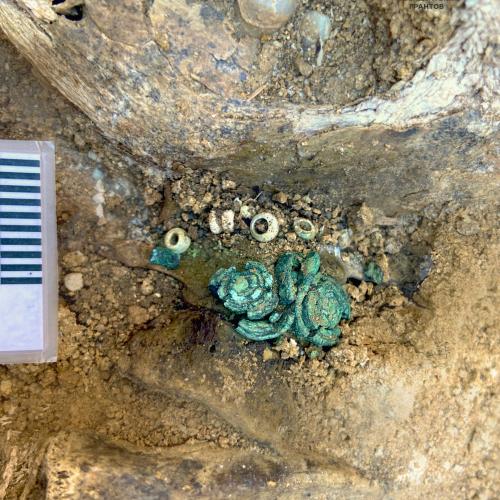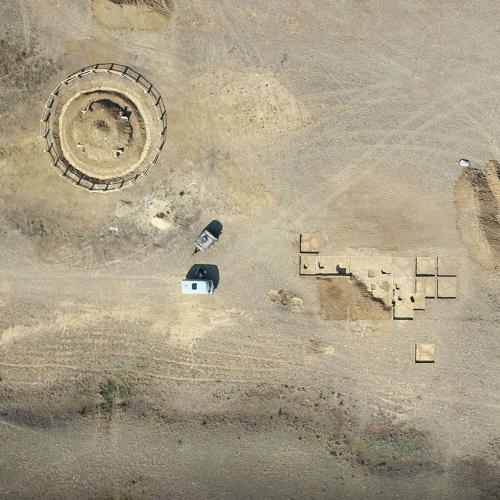В 2020 году обнаружена площадка детских погребений Синташта-VI. Исследования проводились под руководством Г.Б. Здановича, Т.С. Малютиной и Ю.С. Макурова. За три года работ на памятнике вскрыто 22 погребения, из них – 21 детское и 1 взрослое.
Большая часть погребений совершена по обряду ингумации (трупоположение), в двух случаях зафиксирована кремация (трупосожжение). Погребения имеют разную степень сохранности, некоторые скелеты повреждены грызунами. В большинстве ям содержались фрагменты истлевших деревянных перекрытий, т.е. ямы представляли собой небольшие склепы.
Погребенные лежали скорчено на левом боку, с руками, сложенными перед лицом, головой на север. Возраст погребённых (по предварительной оценке) варьируется от младенчества до 7 лет. Сопроводительный инвентарь представлен керамическими сосудами, астрагалами, фаянсовыми бусинами, бронзовым браслетом и бронзовой очковидной подвеской.
Сосуды имеют различные орнаменты с геометрическими элементами (треугольники, ромбы, меандры). Декоры нанесены плоскими палочками или специальными инструментами, напоминающими расчёску – гребенчатым штампом. Один из сосудов имеет орнамент в виде солярного символа, выполненный на дне изделия. При одном из погребенных младенцев сосуды одинаково орнаментированы наколами на горлышках. В сосуды помещали заупокойную пищу, в двух случаях в могиле зафиксированы кости животных.
В нескольких могильных ямах обнаружены астрагалы (надкопытные кости мелкого рогатого скота). В археологической литературе существует насколько интерпретаций: астрагалы могли использоваться в качестве набора для игры в кости, как гадальные кости, как символы благополучия и как обереги.
Погребальный обряд и инвентарь позволяют отнести изученные погребения к позднему бронзовому веку и датировать их в интервале XVIII-XVI вв. до н. э.
Burial Area S-6
The site was discovered by G.B. Zdanovich, in the course of a joint archaeological expedition of the “Arkaim” Reserve and the Charitable Fund “Arkaim” (T.S. Malutina supervised the excavations while G.B. Zdanovich directed the expedition). In 2021-2022 the excavations continued under the directions of T.S. Malutina, Yu. S. Makurov and A.O. Bukacheva. In the course of three years, archaeologists excavated 22 burials that contained the remains of 21 children and one adult. While the majority of the burials were inhumations, archaeologists recorded two cases of cremation.
Burial architecture
The majority of the graves contained fragments of wooden chambers. In other words, the deceased were buried inside of hollow wooden cuboid structures. In some cases, small domed structures made of clay and silt were erected on top of the burials.
Artifacts
The ceramics of S-6 vary in their shape and decoration. The majority of the vessels are decorated in the so-called geometric stye, i.e., the ornaments include triangles, rhombuses, and meanders. The decorations were applied using either flat sticks or special instruments – comb-stamps.
The body of one of the vessels is decorated with an irregular ornament; its bottom is also ornamented. These vessels contained food and drinks that were necessary in the afterlife.
Several graves contained talus (astragalus) bones of sheep/goat. These bones can be interpreted in several ways: playing dice, fortune telling implements, symbols of prosperity and protection.
The burials
In cases of inhumation, corpses were placed on their left sides in a crouched position, with hands folded in front of the face, with heads facing north. The ages of the deceased (according to preliminary analysis) ranges from infants to 7 years old. Grave goods included ceramic vessels, animal astragalus bones, faience beads, and miniature bronze bracelets.
The only adult burial found so far (Burial No. 19) has some peculiar characteristics. The woman (?) was initially placed on her back with knees bent. Such burial position was observed at the BSK. The artifacts found next to the deceased (concentration of beads as well as an “eyeglasses”-shaped bronze pendant) could be remnants of a breastplate. Judging from the traces of oxidation, the woman could have worn a metal bracelet on her right wrist.
The burial ritual, as well as the accompanying artifacts, allow the archaeologists to date the burials to the Late Bronze Age (18th-16th centuries BC)






